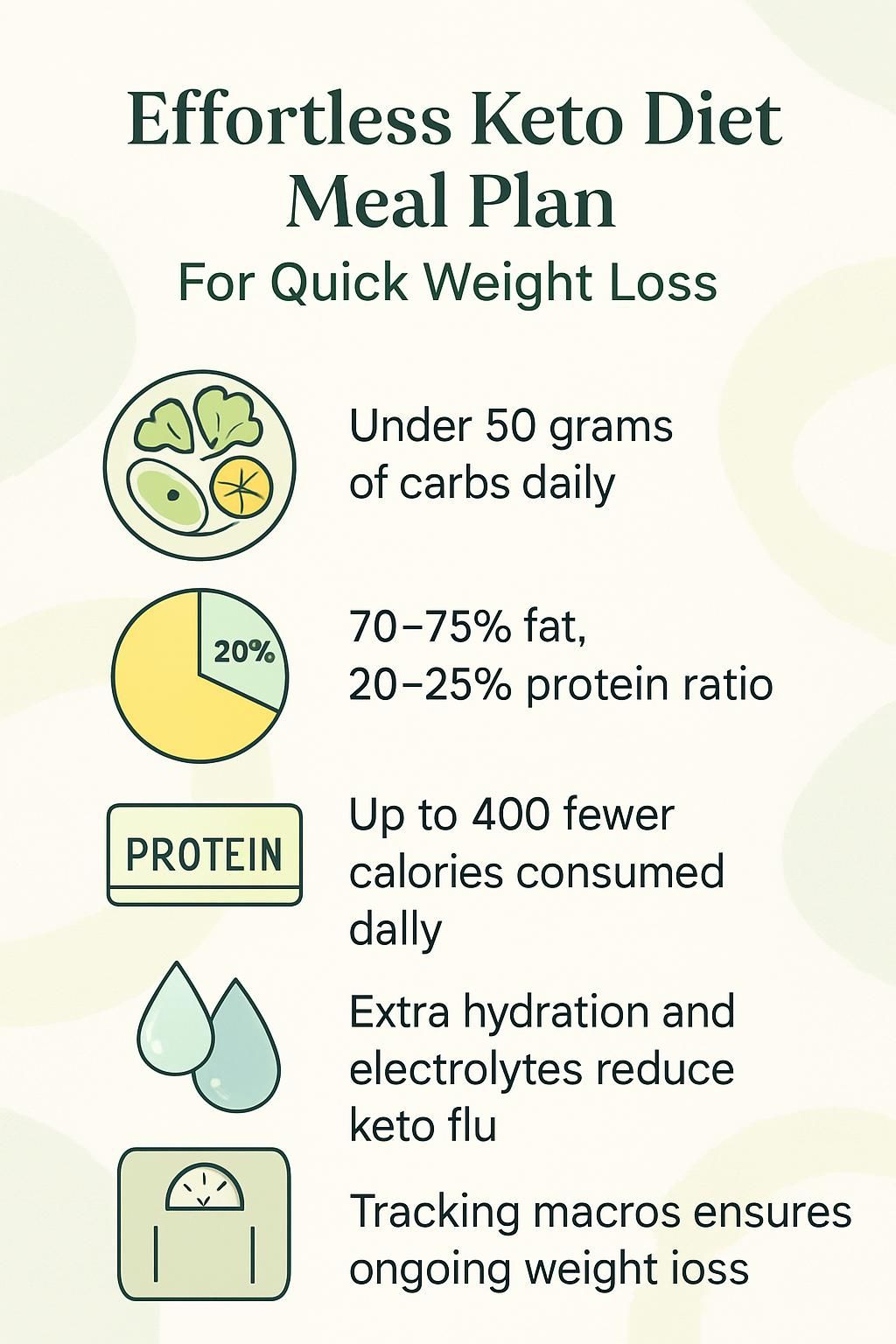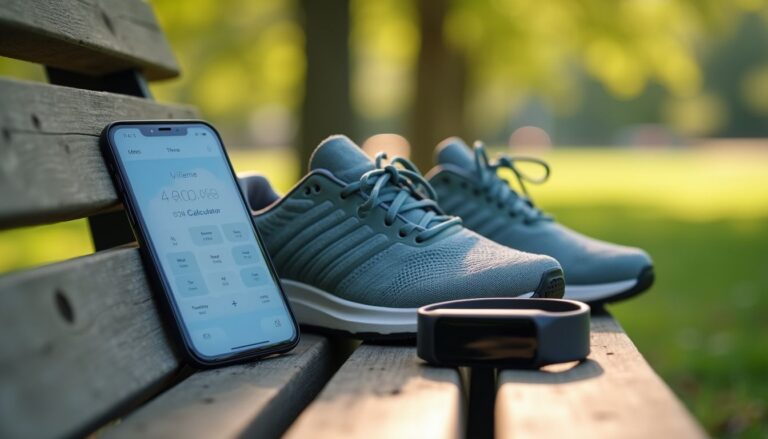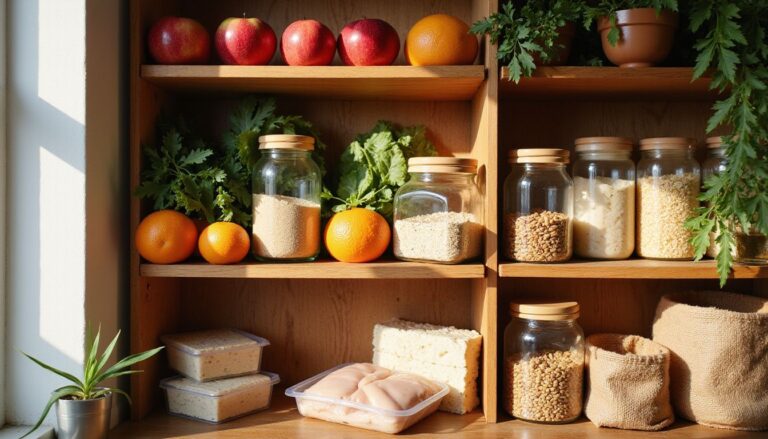Effortless Keto Diet Meal Plan For Quick Weight Loss
Our Nutrition Assistant AI Suite will transform your body. You will lose fat, get toned, and build muscle. Gain confidence and optimal health.
Many people want to lose weight but feel stuck choosing a diet meal. I have been there as well. A structured keto diet meal plan gave me a simple way to cut carbs and see progress.
In this guide, you will find clear steps for healthy keto meals, a simple 7-day keto meal plan, foods to eat and avoid, smart grocery list tips, and ways to stay energized while you lose weight.
You can start with small changes, keep reading for quick solutions you can use today.
Key Takeaways
- Research shows a keto diet under 50 grams of carbs per day can support weight loss up to two to three times faster than low-fat diets (Mansoor et al., 2016).
- A standard ketogenic meal plan usually targets about 70 to 75 percent fat, 20 to 25 percent protein, and 5 to 10 percent carbohydrates by calories to support ketosis.
- High-fat, low-carb meals often reduce hunger and cravings, and some participants ate about 400 fewer daily calories without trying in trials.
- Managing keto flu is easier with extra water and electrolytes, including sodium, potassium from leafy greens or avocado, and magnesium as experts recommend.
- Tracking macros with apps like MyFitnessPal or Cronometer helps keep your fat, protein, and net carbs on target for steady results.

Understanding the Keto Diet Basics

I began keto to lose weight and improve my health with a low-carb plan. Learning the basics helped me set clear goals and stay consistent.
What is a ketogenic diet?
A ketogenic diet is a high-fat, very low-carbohydrate eating plan that shifts the body’s main fuel from glucose to fat. Most people limit carbohydrate intake to about 20 to 50 grams of net carbs per day, then increase healthy fats like avocado, olive oil, nuts, seeds, and butter.
This shift triggers ketogenesis, the liver’s process of making ketone bodies, which your body can use for energy instead of blood sugar. Many clinicians use keto for weight management and for people with type 2 diabetes under medical supervision because it can help with blood sugar control.
When I built my first sample keto meal plan, I tracked my macronutrient ratios in an app. After one week, I noticed lower appetite and steadier energy.
Switching to a low-carb meal plan let me use fat for fuel faster than any other approach.
How does ketosis help with weight loss?
During ketosis, the liver turns stored fat into molecules called ketones. These ketones become the main energy source instead of glucose from carbs. When I keep carbs under 50 grams per day, my body burns fat more efficiently.
Studies suggest that low-carbohydrate diets can support faster weight loss during the first six months compared with higher-carb diets. Insulin levels often drop in ketosis, which means the body stores less fat and uses more for energy.
I also notice fewer hunger spikes because ketones may help steady appetite hormones. That makes it easier to follow a keto plan without constant cravings.
References: Mansoor N. et al., 2016 meta-analysis on low-carb vs. low-fat; Hallberg S.J. et al., 2018 outpatient study on type 2 diabetes.
What are the key principles of a keto diet?
The central goal is to keep carbs low so the body uses fat for fuel. I limit daily carbs, often below 50 grams, and build meals around whole foods.
I focus on healthy fats like avocado, olive oil, nuts, and seeds. I include moderate protein from meat, eggs, fish, or tofu. I avoid high-carb foods like bread, pasta, beans, and sweets. I choose non-starchy vegetables, mainly leafy greens and cruciferous types like broccoli and cauliflower.
My typical macro balance is about 70 to 75 percent fat, 20 to 25 percent protein, and 5 to 10 percent carbs by calories. Keeping my kitchen stocked with keto-friendly meat, dairy, and vegetables helps me stay on track.
Benefits of a Keto Diet for Fast Weight Loss
Many people find keto kickstarts weight loss with simple low-carb meals and snacks. Think of ketosis as flipping your body’s fuel switch from sugar to fat.
How does keto boost fat burning?
A high-fat, very low-carb intake pushes the body into ketosis. In this state, the liver breaks down fat to make ketones, which power your brain and muscles when glucose is scarce.
Keto often lowers insulin, the storage hormone. Lower insulin makes it easier to tap into body fat. A 2020 review reported greater early weight loss on keto compared with low-fat diets. My experience was similar; my clothes fit looser after a few weeks of easy low-carb meals and consistent tracking.
Switching your fuel source is like flipping a metabolic switch,
as Dr. Eric Westman explains.
Can keto reduce appetite and cravings?
Several studies show a ketogenic diet can reduce appetite. After I started a high-fat, low-carb menu, my hunger dropped in the first week. In a 2013 trial, people on keto ate up to 400 fewer calories per day without trying.
Ketones may lower appetite signals in the brain. Balanced meals with fat and moderate protein also help steady blood sugar. That means fewer cravings for sweets or processed snacks.
Does keto increase energy levels?
Less hunger often means fewer energy crashes. Switching to a high-fat plan lets your body use fat for a steady fuel supply.
Many people feel more alert once they adapt, since ketones provide a stable source of energy. I noticed fewer afternoon slumps after my first week. A 2017 paper in Nutrition & Metabolism noted that ketones cross the blood-brain barrier and may support mental clarity. Stable blood sugar on keto can also help with physical stamina.
How does keto improve mental focus?
Keto can support mental focus by supplying the brain with ketones. These are efficient fuel made from fat during ketosis. I have fewer dips in energy and better concentration on busy days.
Some studies report improved memory tasks on low-carb plans compared with high-carb diets. Better blood sugar control throughout the day can also reduce mood swings and boost attention.
Sources: Cahill GF Jr., 2006; Little JP et al., 2014; Westman EC et al., 2007.
Getting Started with a Keto Diet
Starting keto can feel big, yet small actions make it manageable. I use a simple guide to keto so I can build habits that last.
What foods are allowed on keto?
A keto diet is high in fat and low in carbs, so I stock my kitchen with foods that make planning easier.
- Meat: Beef, chicken, pork, turkey, and lamb are solid protein sources that help control hunger.
- Eggs: Eggs are low in carbs and work well for breakfast, lunch, or dinner recipes.
- Fish and Seafood: Salmon, sardines, tuna, and shrimp provide omega-3 fats and almost no carbs.
- Low-Carb Vegetables: Broccoli, spinach, cauliflower, kale, zucchini, and asparagus stay low in net carbs. Roasted broccoli with olive oil is a favorite side.
- Healthy Fats: Olive oil, avocado oil, coconut oil, butter, and heavy cream add the fat needed for ketosis.
- Nuts and Seeds: Almonds, walnuts, chia, and flax add crunch and fiber. I portion them to manage calories.
- Dairy: Full-fat cheese and unsweetened Greek yogurt provide protein and calcium with fewer sugars.
- Berries in moderation: Strawberries and raspberries add flavor without a big blood sugar spike.
- Coffee and tea unsweetened: Black coffee or herbal tea fit my morning routine without extra carbs.
- Tofu and tempeh: These plant proteins support vegetarian or vegan keto meals with few net carbs.
What foods should be avoided on keto?
Some foods raise carbs fast and can knock you out of ketosis. I keep this list close during the first month.
- Sugary items like soda, juice, candy, cookies, cakes, and sweetened yogurt.
- Grains such as bread, pasta, rice, cereal, tortillas, and other flour-based products.
- Starchy vegetables including potatoes, corn, peas, carrots, and parsnips.
- Most fruits are high in sugar. Avoid bananas, apples, grapes, mangoes, pears, and fruit juices.
- Legumes like beans, lentils, chickpeas, and peanuts are higher in net carbs.
- Low-fat or diet items often add sugar or starch. Full-fat dairy usually fits better.
- Processed snacks like crackers and chips often hide carbs from added flours or sugars.
- Sugary condiments such as ketchup and some barbecue sauces can stall ketosis.
- Beer and sweet wine add quick carbs that slow fat loss.
- Regular milk has lactose sugar. Unsweetened almond or coconut milk often works better.
How can I manage keto flu symptoms effectively?
Many people feel keto flu in the first week, like headaches or fatigue. These steps make the transition smoother.
- Drink plenty of water each day to avoid dehydration and reduce headaches or nausea.
- Increase electrolytes. Add sodium, potassium-rich foods like leafy greens or avocados, and consider magnesium if needed.
- Eat more fiber from low-carb vegetables or seeds to support digestion and reduce constipation.
- Add a pinch of salt to meals if you feel cramps or weakness. Early ketosis causes water loss and sodium loss.
- Prioritize sleep. Good rest supports energy while your body adapts to using fat for fuel.
- Keep workouts light during the first few days. Increase intensity once energy stabilizes.
- Choose whole foods from your pantry or local grocery store. Build meals around meat, eggs, cheese, fish, nuts, and berries.
Health disclaimer: This guide is general information, not medical advice. Talk with a healthcare professional before starting a low-carb diet, especially if you take medications, are pregnant, or have diabetes.
The next step is a simple 7-day plan you can use right away.
7-Day Keto Diet Meal Plan Examples
A 7-day keto meal plan removes guesswork and speeds up prep. I keep the meals simple and repeat favorite items to save time.
What can I eat for breakfast, lunch, dinner, and snacks on Day 1?
Breakfast: Scrambled eggs cooked in olive oil with spinach and shredded cheddar. Add sliced avocado for extra fat. This mix of protein and fat keeps me full all morning.
Lunch: Grilled chicken salad with leafy greens, cherry tomatoes, cucumber, walnuts, and olive oil vinaigrette. It delivers fiber while keeping carbs low.
Dinner: Baked salmon with lemon and a side of roasted broccoli tossed in coconut oil. Snacks: Celery with almond butter or a small portion of macadamia nuts.
These choices stay gluten free and avoid hidden sugars often found in packaged foods.
What are keto meals for Day 2?
Breakfast: Scrambled eggs in olive oil topped with avocado slices. Add a small handful of berries for fiber.
Lunch: Grilled chicken breast over greens with sliced almonds and a light vinaigrette.
Dinner: Sautéed salmon, steamed broccoli, and a small serving of cauliflower rice. Snacks: Mixed nuts or cheese sticks as needed.
These meals focus on whole foods to support steady energy and appetite control.
What does Day 3’s keto meal plan look like?
Breakfast: Scrambled eggs with avocado and a side of sautéed spinach.
Lunch: Grilled chicken breast over mixed greens, tossed with olive oil and a few berries for color and fiber.
Dinner: Salmon cooked in coconut oil with roasted broccoli. Snacks: Celery sticks with almond butter or a handful of seeds.
Every item supports ketosis and delivers key nutrients you need during the week.
What meals are planned for Day 4?
Breakfast: A cheese omelet cooked in olive oil with a side of fresh berries. About 5 grams of net carbs total.
Lunch: Grilled chicken over mixed greens with avocado and walnuts, a tasty source of heart-healthy fats.
Dinner: Baked salmon with roasted broccoli and cauliflower. Snacks: A handful of almonds or macadamia nuts.
Salmon provides omega-3 fats that support heart health. Your body makes ketones when carbs stay low.
What is the Day 5 keto menu?
Breakfast: Scrambled eggs in butter with fresh spinach and a side of avocado.
Lunch: Grilled chicken salad with olive oil dressing. Add a few almonds for crunch.
Dinner: Baked salmon with roasted broccoli. Dessert: A small portion of berries with whipped heavy cream.
This menu keeps me in ketosis and helps control cravings, all while keeping net carbs very low.
What should I eat on Day 6?
Breakfast: Scrambled eggs in olive oil topped with shredded cheese.
Lunch: Grilled chicken breast with a spinach salad, almonds, and half an avocado for healthy fats.
Dinner: Pan-seared salmon with roasted broccoli and cauliflower rice. Snack: Raspberries for a sweet bite with fiber.
I sip water, add a sprinkle of sea salt to meals, and keep electrolytes up to avoid keto flu symptoms.
What are the meals for Day 7?
Breakfast: Scrambled eggs in olive oil with a side of avocado.
Lunch: Grilled chicken breast with roasted broccoli and a simple green salad.
Dinner: Pan-seared salmon with sautéed spinach and mushrooms. Snacks: Pork rinds or celery sticks with cream cheese.
This day keeps total carbs under 25 grams and supports ongoing fat burning. Prepping ingredients ahead makes the week easier.
Easy Keto Recipes for Every Meal
I like easy recipes that fit a busy schedule. Simple methods help me stick to my goals and enjoy the food.
What are some low-carb keto breakfast ideas?
Breakfast should be low in carbs, satisfying, and quick. I aim for under 10 grams of net carbs per serving.
- Scrambled eggs with spinach and avocado, about 5 grams of carbs.
- An omelet with mushrooms, cheese, and bell peppers, usually under 7 grams.
- Greek yogurt with chia seeds and raspberries for probiotics and fiber.
- Keto pancakes using almond flour, often fewer than 6 grams per serving.
- Smoked salmon rolled with cream cheese for a no-cook option.
- Breakfast sausage with sautéed kale for a hearty, low-carb plate.
- Chia pudding made with coconut milk for a fast, cold breakfast.
What keto-friendly lunch options can I try?
A good keto lunch gives steady energy and keeps carbs low. I often pick one of these quick options.
- Grilled chicken salad with greens, tomatoes, avocado, and olive oil dressing.
- Tuna lettuce wraps with mayo, celery, and mustard in crisp romaine.
- Egg salad with mayo, diced pickles, and fresh dill, under 5 grams net carbs.
- Zucchini noodles with rotisserie chicken and a creamy Alfredo sauce.
- Turkey and cheese roll-ups with mustard for dip.
- Cobb salad with eggs, bacon, cucumber, blue cheese, and sugar-free ranch.
- Cauliflower rice stir-fry with shrimp, garlic, peppers, and soy sauce or coconut aminos.
What simple keto dinner recipes are available?
Simple dinners make weeknights less stressful. I stick to whole ingredients and aim for under 10 grams of net carbs per serving.
- Grilled chicken breast with roasted broccoli and olive oil.
- Zucchini noodles in pesto topped with grilled shrimp.
- Baked salmon with a spinach and avocado salad.
- Cauliflower fried rice with ground turkey and diced peppers.
- Eggplant lasagna with ricotta, no-sugar marinara, and mozzarella.
- Beef taco bowls using lettuce leaves instead of tortillas.
- Chicken thighs in butter with garlic green beans.
What healthy snacks fit a keto diet?
Smart snacks prevent cravings and keep daily carbs in check. I choose items with protein or fat and almost no sugar.
- Cheese sticks for portable protein.
- Hard-boiled eggs with less than 1 gram of carbs each.
- Avocado slices with sea salt for fiber and healthy fat.
- Raw almonds or walnuts, a small handful for 2 to 3 grams net carbs.
- Celery with cream cheese for crunch and fullness.
- Sliced cucumber topped with guacamole.
- Turkey roll-ups made with nitrate-free deli slices and cheddar.
- Olives for flavor and monounsaturated fat.
- Pork rinds for a chip-like crunch with no carbs.
- Sugar-free beef jerky, checking labels for hidden sugars.
Tips for Keto Meal Prep and Planning
Planning keeps me consistent and saves time. A little prep once or twice a week sets up the whole plan.
How do I create a keto weekly shopping list?
I review my 7-day meal plan and list ingredients for every breakfast, lunch, dinner, and snack. I group items by category to shop faster: proteins like chicken thighs, eggs, and salmon; low-carb vegetables like spinach and broccoli; healthy fats like avocados and olive oil; dairy like cheddar or Greek yogurt; nuts or seeds like almonds and chia; and pantry items like coconut flour.
I double-check labels to keep net carbs below my daily target. Buying produce in bulk helps me prep ahead for busy days and reduces waste.
What are meal prep tips for busy people on keto?
I plan simple meals that share ingredients to cut cost and effort. I batch cook proteins like grilled chicken or ground beef, then pair them with quick sides such as steamed broccoli or a spinach salad.
I store meals in portioned containers for grab-and-go lunches. Tools like a slow cooker or air fryer reduce hands-on time. I keep hard-boiled eggs and cheese sticks ready to prevent impulse snacking.
How can I stay consistent with my keto diet?
A regular meal schedule reduces random snacking. I prep ingredients on weekends so weeknights stay simple.
I track meals in an app to see if my macros match my goals. I keep quick keto snacks on hand, like nuts or cheese, and focus my list on whole foods, lean meats, greens, and healthy fats.
Overcoming Common Keto Diet Challenges
Sticking with keto is easier with a plan. Here are the strategies I use when life gets busy or social plans pop up.
How do I track macros accurately on keto?
I weigh ingredients with a digital scale before cooking. I log everything in a food app like MyFitnessPal or Cronometer to see carbs, protein, and fat per meal.
I check nutrition labels and use USDA FoodData Central to confirm macro counts. My target is often around 70 percent fat, 20 percent protein, and 10 percent net carbs by calories. Measuring oils, dressings, and cheese helps me avoid portion creep.
How can I handle social situations while on keto?
I bring keto-friendly snacks to gatherings to avoid high-carb foods. At restaurants, I order meat, fish, or salads and ask for dressing on the side. Swapping fries for extra vegetables is usually easy.
I share my goals with friends so they can support me. If the menu looks carb heavy, I eat before going or bring a dish to share. Focusing on people and activities makes food less central.
How do I find and avoid hidden carbs in foods?
I read labels for added sugars and starches in packaged foods. Ingredients like maltodextrin, dextrose, rice flour, and corn syrup can add surprise carbs.
Restaurants sometimes add sugar or flour to sauces and dressings, so I ask for details. I measure portions because even low-carb foods add up if I eat more than a serving.
Long-Term Keto Diet Maintenance
Long-term success comes from small, steady habits. I rotate favorite keto meals and keep my routine flexible.
When and how should I switch to maintenance mode?
After reaching my goal weight, I looked for signs that my body needed a change. If weight holds steady for two weeks while sticking to the plan, I consider maintenance.
I increase carbs slightly, for example from 20 to 30 grams up to about 50 grams per day. I add small portions of berries or root vegetables and watch how I feel. I keep tracking to protect energy and blood sugar.
How should I plan cheat days on keto?
I set clear rules for cheat meals. I plan them in advance and keep them rare, sometimes once every few weeks. I choose options lower in sugar when I can.
I pay attention to how my body responds afterward, such as cravings or fatigue. Frequent high-carb cheats can slow progress and increase hunger.
Reference: Hallberg SJ et al., Obesity (Silver Spring), 2018.
How can I adjust my macronutrient ratios over time?
If I hit a plateau or feel low energy, I adjust. I may raise healthy fats like olive oil and avocado, and slightly lower protein. During heavier training weeks, I increase protein for recovery while keeping net carbs under about 30 grams.
I make changes slowly and watch for headaches or cravings. Most people do well near 70 percent fat, 20 percent protein, and 10 percent carbs on standard keto, but small tweaks help me match my needs.
Conclusion
Effortless keto meal planning is possible with simple routines. A clear keto diet meal plan, a short shopping list, and easy recipes keep carbs low and energy stable. Evidence suggests keto can support faster fat loss and better focus for many people.
Each meal in your plan can help curb hunger, protect energy, and move you closer to your goals. Stay consistent, track your macros, and seek medical guidance if you have health conditions or take medication. With a steady low-carb approach, progress adds up week after week.
Citations: Mansoor N. et al., 2016; Hallberg S.J. et al., 2018; Nutrition & Metabolism, 2017; additional sources noted in sections above.
FAQs
1. What is an effortless keto diet meal plan for quick weight loss?
An effortless ketogenic eating schedule uses low-carbohydrate, high-fat foods to help the body burn fat for energy. This approach can lead to rapid weight reduction when combined with proper calorie control and regular physical activity. Studies show that following a structured ketogenic menu may result in greater short-term fat loss compared to traditional low-fat diets.
2. Which foods should I include in my keto meal plan for best results?
Choose protein-rich items like poultry, fish, or eggs; healthy fats such as olive oil or avocado; and non-starchy vegetables including spinach or broccoli. Avoid bread, pasta, rice, potatoes, and sugary snacks since these raise carbohydrate intake above recommended levels for ketosis.
3. How quickly can I expect to lose weight on a keto diet meal plan?
Research indicates that many people experience significant reductions within two to four weeks of starting a well-formulated ketogenic program. The rate depends on factors like initial body mass index (BMI), adherence level, daily caloric deficit, and individual metabolism rates.
4. Are there any risks linked with following an effortless keto diet meal plan?
Some individuals report temporary side effects such as fatigue or headaches during the first days of carbohydrate restriction; this is sometimes called “keto flu.” Long-term use without medical supervision could affect kidney function or nutrient balance according to clinical studies published by reputable health organizations.
Summary: A carefully planned ketogenic eating routine focuses on reducing carbs while increasing healthy fats and proteins from whole food sources like poultry and leafy greens. Evidence supports its effectiveness for fast fat loss but highlights the need for balanced nutrition and monitoring potential side effects under professional guidance.







